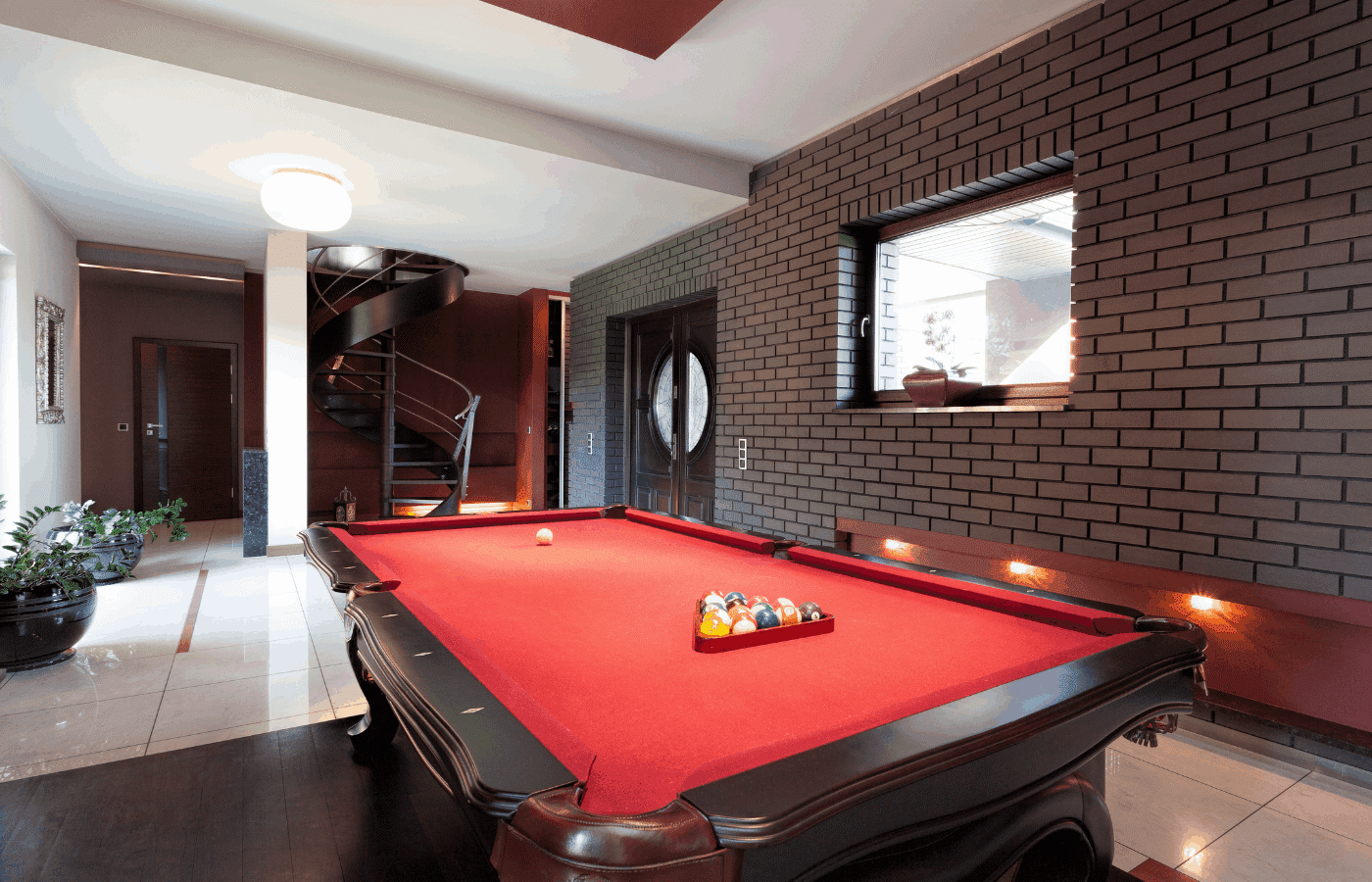If you love pool, you’ve probably thought about buying your own table at some point. Or perhaps you’re opening a bar to which you think pool tables would be a good addition.
The simple answer is yes, pool balls could potentially crack ceramic and porcelain tiles. The likelihood of a pool ball breaking your tile floor depends on the strength of your tiles.
Keep reading to find out more, as we’ll explore how exactly pool balls can break ceramic and porcelain tiles and whether or not you should place a pool table on a tiled floor.
What are Pool Balls Made of?
To understand whether or not a pool ball will break your flooring, you first have to understand the pool ball itself.
Originally, when pool was first invented, balls were usually made from ivory. Ivory is derived from the tusks of animals, so is now a banned material. Instead, pool balls in modern times are usually made from plastic or resin. These materials guarantee the same density in each ball, similar to ivory, making them an ideal replacement.
Resin and plastics are also more resistant to scratches, chips, and other wear and tear, which makes them an ideal replacement to the original ivory balls.
Did you know? Aramith Tournament Pool Balls are crafted with the highest quality phenolic resin and are designed to last up to 5 times longer than the average billiard ball.
Will Pool Balls Crack Ceramic Tiles?
Whether or not a pool ball will crack your ceramic tile depends on the quality of the tiles themselves and the quality of the job done on your flooring.
If you have high quality ceramic tiles which are fairly dense, and you had a professional person lay your tile floor, then the chances of a pool ball breaking the tiles are fairly slim.
When ceramic tiles are relatively thin or low in density, they’re likely to break if something hard and heavy like a pool ball lands on them. Similarly, if you had a poor flooring job, then there are likely pockets of air underneath the tiles.
This means there’s no solid foundation below them to absorb the shock of something heavy falling onto them.
Without this solid foundation, they will likely shatter if hit with a pool ball or something similar.
One thing to consider when thinking about whether pool balls will break your ceramic tiles is the Porcelain Enamel Institute, also known as PEI, rating.
This rating assesses the durability of ceramic tiles and gives them a score accordingly. A score of 5 means they can be used for pretty much anything and can withstand heavy foot traffic, while a score of 2 means they only ought to be used for something like a bathroom wall as they’re not especially durable.
Will Pool Balls Crack Porcelain Tiles?
Generally, porcelain is considered slightly more hard-wearing than ceramic. This is because they have a higher density, meaning they can handle more pressure before breaking.
This means that porcelain has a little less chance of breaking against a pool ball than ceramic.
Glazed porcelain generally doesn’t need a PEI rating, because it’s automatically considered highly capable of dealing with large weights and shocks.
The fact that pool balls are now made of resin or plastic instead of a hard, solid substance such as ivory also means they’re less likely to crack porcelain tiles.
Can You Put a Pool Table on Tile?
Well, the answer depends on the type of tiles you have. If you have porcelain tiles, especially if they’re glazed, then the likelihood is that you’re able to put your pool table on the tiles without any problems.
This is because the pool ball, and the table itself, are unlikely to cause cracks to your flooring due to their durability.
However, if you have ceramic tiles, it’s probably best to either find out their PEI rating before placing a pool table on them, or thinking back to when you got the floor fitted to determine whether the job was good enough to have tiles that won’t crack.
If you’re fairly confident that your tiles were placed well and don’t have any air bubbles underneath them, then you can go ahead and place a pool table on them. If not, then perhaps consider placing the table elsewhere!
It’s always a good idea to keep a pack of spare tiles on hand in the event that one does crack. They can usually be replaced fairly easily without the need of a flooring specialist.
Alternatives to Tiled Floors for Pool Balls
So, what are the alternatives if you’re not willing to risk your beautifully tiled floor for a pool table? Great news – there’s many!
Carpet
Carpet, or a rug underneath the pool table, are two of the best options for flooring when it comes to setting up a pool table.
A rug is a great idea if your house is mainly tiled and doesn’t have any permanent carpet fixtures. Your best bet is to get a rug that is a fair bit larger than the actual pool table itself.
This will mean that your stance isn’t thrown off when playing as you’ll be standing completely on the rug and not half on the floor, which is at a slightly different height.
It also guarantees that the table will be completely flat and won’t move around on the floor, again promising you a better game.
Besides cracks in the tiles, one of the issues that people who place pool tables on ceramic or porcelain floors sometimes face is the pool table moving around. If this happens mid-play, it can be catastrophic to your gameplay!
Having an area rug, even if you’re fairly certain that your tiled floor is solid, is therefore a sensible idea for anyone wanting to place a pool table in their home.
Wood
Another favorite flooring for most pool lovers is wood. Generally, in bars or pubs which have pool tables, you’ll find wooden flooring. This is because the pool balls are unlikely to damage the wood, and the wood is equally as unlikely to damage the pool balls should they land on the floor.
One issue you might face with wood is the table moving around slightly or marking the floor. To avoid this, you can simply place cardboard underneath each leg (though make sure it is the same amount under each foot), or alternatively, use furniture pads which can be bought form most furniture stores.
Wood holds heat much better than tiles or carpet do, so it’s also a great option if you’re looking to put your pool table in an area of the house that usually gets cold. It will provide a more comfortable space to play pool in, and also avoid any changes to the pool table as it won’t get too cold.
Linoleum
Beyond carpet and wooden flooring, your best option is probably linoleum. More commonly known as ‘lino’, it is similar to wood in the fact that it won’t damage your pool table or balls, and nor will they damage the flooring.
Lino is great for anyone looking to experiment with the design of their flooring, particularly if you’re looking to create a pool room! Lino offers more crazy colors and designs than wood, carpet, or tiles can, and also comes at a fraction of the price.
It can also be cleaned much easier than the other floor materials outlined above, making it ideal if you frequently host pool parties or contests in your home.
Rubber Mat
A rubber mat is somewhat similar to an area rug, but simply made out of rubber instead of fabrics. Most people who use a rubber mat have a tiled floor, and use the mat to protect the table, pool balls, and the flooring.
A rubber mat is ideal because it has the same advantages as a rug, however is easier to clean, and generally much cheaper.
The downsides of a rubber mat are that you need to find one that isn’t too shiny, otherwise the table could move around on it whilst you are playing pool. Also, they generally don’t look as nice as carpets or wooden floors.
Final Thoughts
To answer the original question, pool balls could crack tiles, but probably won’t if your tiles are strong and have been properly laid. If you have porcelain tiles, then you are probably fine. If you have ceramic tiles, perhaps double check their PEI rating before putting a pool table in.
Regardless of which tiles you have and their durability, it’s a good idea to have some spare tiles in your house, just in case a pool ball does happen to crack one. Alternatively, you could buy a rubber mat or area rug if you were wanting to protect the area without buying an entirely new floor.
Great alternatives to placing your pool table on a tiled floor are placing it on carpet or wooden surfaces, as well as getting furniture pads which sit underneath the feet of the pool table and prevent it from damaging the floor. Linoleum is also a perfect option if you’re looking for a luxurious looking floor that can handle pool balls at a lower price.


